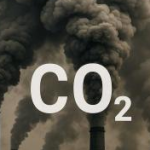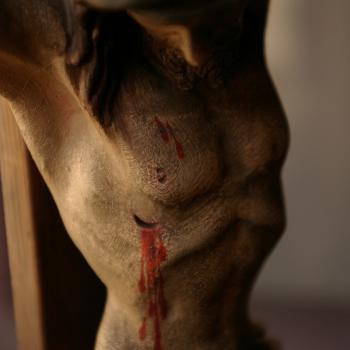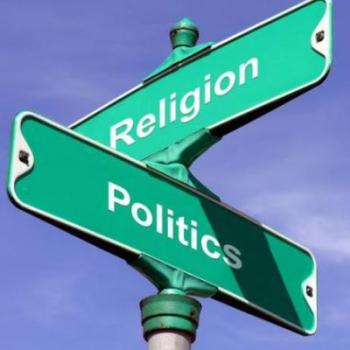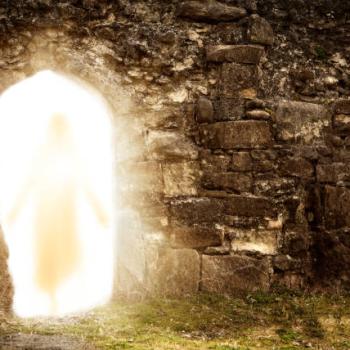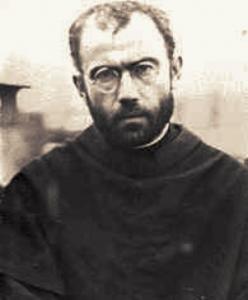
Today is the feast day of St. Maximilian Maria Kolbe, priest, missionary, founder of monasteries, publisher, amateur radio broadcaster, prisoner, and martyr. He was canonized by Pope John Paul II on October 10, 1982, and declared a martyr of charity. He is the patron saint of drug addicts, political prisoners, families, journalists, and the pro-life movement. Pope John Paul declared him “the patron saint of our difficult century.” He died at Auschwitz on this day in 1941.
Born January 8, 1894, and baptized Rajmund Kolbe, he was a mischievous child until the age of 12, when he had a vision of the Virgin Mary. After a particularly impressive scolding from his mother, he asked the Mother of God
… what was to become of me. Then she came to me holding two crowns one white, the other red. She asked me if I was willing to accept either of these crowns. The white one meant that I should persevere in purity, and the red that I should become a martyr. I said that I would accept them both. (Catholic Online)
A year later he joined the Conventual Franciscans, taking the religious name Maximilian in 1910. On taking final vows in 1914, he added the name Maria because of his deep devotion to the Virgin Mary.
Publications, monasteries, and Nazis
In Rome he studied philosophy, theology, mathematics, and physics, earning doctorates in both philosophy and theology. There he witnessed violent demonstrations against the Catholic Church. I have not been able to find what cause the demonstrators may have been pursuing. In opposition to these and for the conversion of sinners and enemies of the Church, Maximilian founded the Militia Immaculata. The “Army of the Immaculate One” published informative and devotional pamphlets, a daily newspaper and a monthly magazine. The latter two had circulations of 230,000 and over a million respectively.
In 1919, now a priest, Maximilian returned to Poland. He founded a monastery near Warsaw, a seminary, a radio station, and several other organizations and publications. As the Nazi movement rose to power in Germany, the monastery issued many anti-Nazi publications in German. Maximilian also condemned Nazi activities, reporting as an amateur radio operator.
When Germany invaded Poland in 1939, Maximilian sent most of the monastery’s friars home for their safety. He and the few remaining turned the monastery into a shelter for 3000 Polish refugees, including 2000 Jews. A Holocaust site says,
The friars shared everything they had with the refugees. They housed, fed and clothed them, and brought all their machinery into use in their service. Inevitably, the community came under suspicion and was watched closely. Then in May 1941 the friary was closed down and Maximilian and four companions were taken to the deathcamp Auschwitz, where they worked with the other prisoners.
The martyr
At Auschwitz, there was a rule that, if any prisoner escaped, 10 others would die, by starvation, in retaliation. How Maximilian offered his life in exchange for one of 10 so condemned is common knowledge. Not so well-known is his day-to-day heroism and self-sacrifice. This site includes testimonies to his character:
- A doctor who treated him after he had been beaten and left for dead: “I can say with certainty that during my four years in Auschwitz, I never saw such a sublime example of the love of God and one’s neighbor.”
- A Protestant doctor recalled how Fr. Kolbe sacrificed himself for others, waiting until all others had been helped.
- The condemned man, who survived four more years of imprisonment, later recalled how he felt. “For a long time I felt remorse when I thought of Maximilian. By allowing myself to be saved, I had signed his death warrant. But now, on reflection, I understood that a man like him could not have done otherwise. Perhaps he thought that as a priest his place was beside the condemned men to help them keep hope. In fact he was with them to the last.”
A Nagasaki monastery and the atomic bomb
The July 14 entry in Common Prayer: A Liturgy for Ordinary Radicals contains a detail that connects Maximilian’s story to Nagasaki, Japan, and the atomic bomb. Here is the story as Common Prayer tells it:
Maximilian had also lived in Japan and founded a monastery on the outskirts of Nagasaki. Four years after his martyrdom, on August 9, 1945, the atomic bomb was dropped on Nagasaki, but his monastery miraculously survived.
The Jewish Virtual Library explains further. Maximilian’s mission work in Japan extended from 1930 to 1936. He built a monastery and a seminary and founded a Japanese paper.
The monastery he founded remains prominent in the Roman Catholic Church in Japan. Kolbe decided to build the monastery on a mountain side that, according to Shinto beliefs, was not the side best suited to be in tune with nature. When the atomic bomb was dropped on Nagasaki, Kolbe’s monastery was saved because the blast of the bomb hit the other side of the mountain, which took the main force of the blast. Had Kolbe built the monastery on the preferred side of the mountain as he was advised, his work and all of his fellow monks would have been destroyed.
A closing comment from Common Prayer:
Maximilian’s feast day, when Christians around the world celebrate his life and sainthood as a hero of the church, falls one week after Nagasaki Day. Each year, we spend the week reflecting on the best and the worst that human beings are capable of.
Image credit: Pinterest via Google Images



